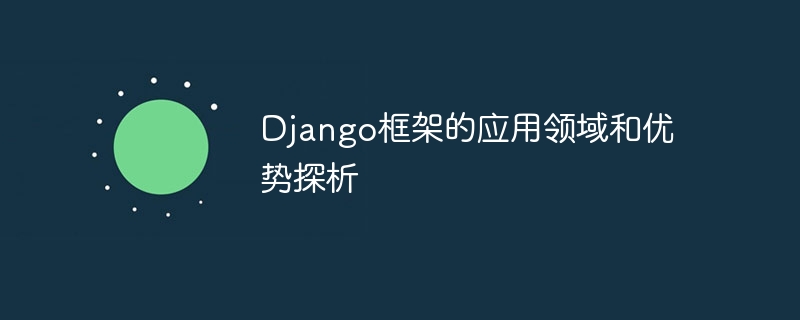Home >Backend Development >Python Tutorial >Analysis on the application fields and advantages of Django framework
Analysis on the application fields and advantages of Django framework
- WBOYWBOYWBOYWBOYWBOYWBOYWBOYWBOYWBOYWBOYWBOYWBOYWBOriginal
- 2024-01-19 10:43:171239browse

Analysis on the application fields and advantages of Django framework
Introduction:
Django is a Web application framework developed using Python language. It adheres to the "rapid development" "'s philosophy is known for its simplicity, efficiency, security and scalability. This article will explore the application areas and advantages of the Django framework and give specific code examples.
1. Application fields:
- Website development
Django is suitable for developing websites of various sizes, whether it is a small personal blog or a large enterprise-level website, Django can competent. Django provides a powerful model layer, view layer and templates, allowing developers to quickly build websites and easily handle common needs such as user authentication, permission control, and data migration. - Database-driven applications
Django supports a variety of database backends, such as MySQL, PostgreSQL, SQLite, etc., so it is suitable for building various database-driven applications. Whether you are developing an e-commerce platform or a management system, Django can provide efficient ORM (Object Relational Mapping) tools, which greatly simplifies the interaction with the database and improves development efficiency. - RESTful API development
With the popularity of mobile Internet, the development of RESTful API has become an important requirement. The Django framework has built-in powerful view classes and routing systems, which can easily develop API interfaces that comply with RESTful design principles. At the same time, Django's authentication and permission system can also well support API security. - Data Visualization
Django provides many convenient tools and libraries, such as Django Admin, django-charts, etc., for the development of data visualization. Through these tools, developers can quickly build various charts and reports to provide users with intuitive and interactive data display.
2. Analysis of advantages:
- Highly automated
The Django framework follows the principle of "convention over configuration" and provides many automated tools and mechanisms, making Developers only need to focus on the core business logic without paying too much attention to the underlying details. For example, Django's model layer can automatically generate database table structures, greatly reducing the workload of manually building a database; Django's form class can automatically generate form fields and validation rules, reducing the burden of front-end development. - Rich plug-in ecosystem
Django has a large and active plug-in ecosystem, and the emergence of various plug-ins provides developers with a wealth of choices. These plug-ins can be used to speed up development, enhance functionality, improve performance, etc. For example, django-debug-toolbar can provide detailed performance analysis information in debug mode, and django-rest-framework provides a complete set of tools and components for RESTful API development. - Excellent security and scalability
The Django framework attaches great importance to security and has built-in multiple mechanisms, such as cross-site request forgery (CSRF) protection, SQL injection protection, etc. At the same time, Django also provides a flexible authentication and permission system that can be customized according to application needs. In addition, Django's scalability is also one of its advantages. Through the plug-in mechanism and rich API interfaces, function expansion and customized development can be easily carried out.
Code example:
The following is a simple Django example that shows how to use Django to develop a simple blog application.
-
Create a Django project:
$ django-admin startproject myblog
-
Create a blog application:
$ cd myblog $ python manage.py startapp blog
-
at
blog/models.pyDefine a blog post model in the file:from django.db import models class Post(models.Model): title = models.CharField(max_length=100) content = models.TextField() pub_date = models.DateTimeField(auto_now_add=True) def __str__(self): return self.title -
Define a view blog post in the
blog/views.pyfile View of the list:from django.shortcuts import render from .models import Post def post_list(request): posts = Post.objects.all() return render(request, 'blog/post_list.html', {'posts': posts}) -
Define a routing rule in the
blog/urls.pyfile:from django.urls import path from .views import post_list urlpatterns = [ path('', post_list, name='post_list'), ] -
In
blog/templates/blog/post_list.htmlWrite the HTML template in the file:{% for post in posts %} <h1>{{ post.title }}</h1> <p>{{ post.content }}</p> <p>{{ post.pub_date }}</p> {% endfor %} -
Include the blog in the project's
urls.pyfile Application routing rules:from django.contrib import admin from django.urls import include, path urlpatterns = [ path('admin/', admin.site.urls), path('', include('blog.urls')), ]
Through the above steps, we have completed the development of a simple blog application. When accessing the root path, a list of blog posts will be displayed, showing the title, content, and publication date.
Conclusion:
The Django framework has a wide range of applications in website development, database-driven applications, RESTful API development, and data visualization. Its high degree of automation, rich plug-in ecosystem, and excellent security and scalability make Django the first choice for many developers. I hope that through the analysis and code examples of this article, readers can better understand and use the Django framework.
The above is the detailed content of Analysis on the application fields and advantages of Django framework. For more information, please follow other related articles on the PHP Chinese website!

